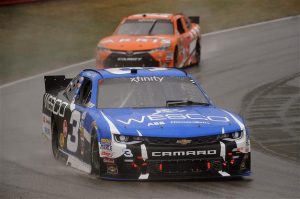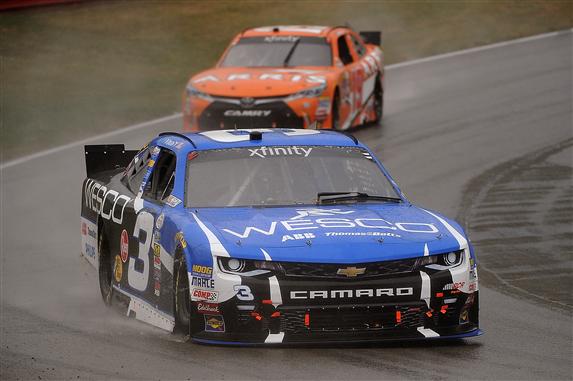
This weekend is the final off-weekend for Sprint Cup competition of the 2016 season. It’s a weekend that many drivers are savoring for a lot of reasons, especially considering that next year those off-weekends are reduced down to just two. That’s something many teams are upset about, but can’t change.
Some drivers went on trips, others stayed home to be around the shop, one got engaged, and another still longs to get back at the wheel of the race car.
Meanwhile, to at least have some NASCAR satisfaction over the weekend, the Xfinity Series took to Mid-Ohio on Saturday for their annual race, their second of three road course races on the season.
What made this event rather fun, depending on the perspective you look from, is the fact that the weather that was shown did not look great. At the green flag, conditions were dry, but after only a few laps the caution waved because of the rain. But, teams came to pit road and quickly made the move from having the slick Goodyear Eagles on all corners to the grooved rain tires that NASCAR brings to every road course.
Considering how different these tires are compared to the original look and design of the rain tire used for the first time in competition years ago, these cars handled incredibly well.
The design of the tread is based on an actual Goodyear street tire that you would see on a mid-size car that one would take to work during the week. The new tire compared to the racing slick is vast. The slick tire used on normal weekends for NASCAR has 3/32nds of tan inch of tread on it when new, and measured at the markers imprinted on the tires. Quite different when the average car tire has approximately 5/16ths of an inch of tread to drive on.

The Goodyear rain tire, in comparison, at it’s deepest point is 3/16ths of an inch of tread, with half of that dept being the tread being cut to make it the rain tire.
Seeing these heavy cars run in wet conditions still is amazing to me as originally the concept of NASCAR running in the rain has never even been thought of for many years. The original rain tires alone were over 10 years old when they were first used in competition, and the reason why they were still good is they were kept in a controlled environment to prevent cracking of the rubber and dry rot. Now, Goodyear treats these tires exactly the same as they do the dry tires, just so the fans can get a great show despite having to wear ponchos.
At the same token, these tires are only half proven.
The only way these tires will have been proven to be good for NASCAR is when the time comes to bolt them onto the Cup cars. And unfortunately, that opportunity has passed for this season. In reality, the Cup drivers overall are in the dark on exactly how to run in the rain. And those that have even tested the waters, pun intended, of running in wet conditions are now retired or onto other racing genres.
Those came back in 2000 when Mark Martin, Robby Gordon, and Jeff Burton all took laps during an abbreviated practice session at Watkins Glen.
Unless a Cup regular pulls double duty, or even decides to take on an extra weekend just for the experience of racing in wet conditions, every driver that would take the green flag is a pure rookie. Sure some have road racing experience in the rain, but not with these cars. It is an absolute first should Sprint Cup actually put on the grooved tires, the wipers and brake lights.
Considering how this area has been lacking rain, it seemed appropriate that on the one weekend the main series was off that it would rain. But it certainly made for quite the show.
It’s the stretch run for the Sprint Cup Series next weekend beginning at Bristol, and the chase is on to make it into the title hunt.



